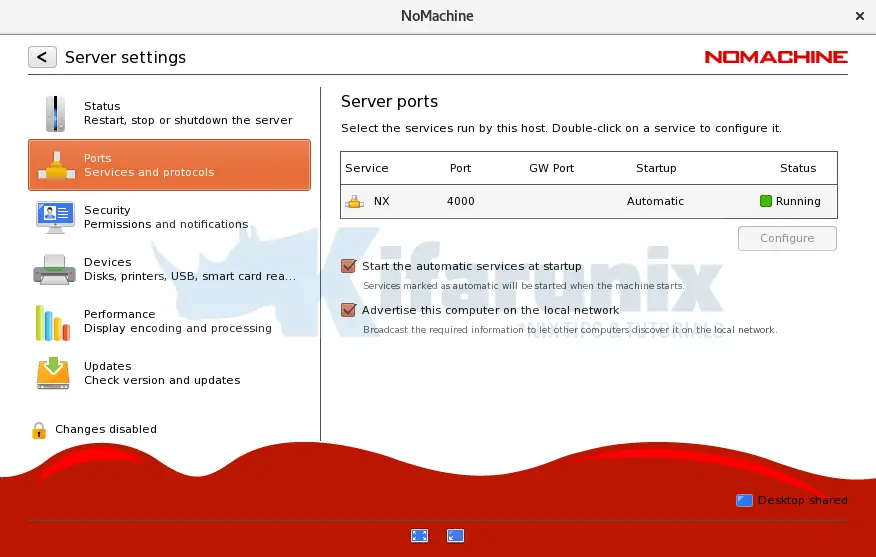

- INSTALL NOMACHINE LINUX INSTALL
- INSTALL NOMACHINE LINUX 64 BIT
- INSTALL NOMACHINE LINUX ARCHIVE
- INSTALL NOMACHINE LINUX DOWNLOAD
click on the !M icon in the system tray or NoMachine service from the system apps as shown in the screenshot above.
INSTALL NOMACHINE LINUX 64 BIT
32 and 64 bit is provided with different setup files so we will select 64 bit for this tutorial. We will use deb for Ubuntu, Debian, Mint, and Kali installation. For Linux, NoMachine is provided as RPM,DEB,TAR.GZ.
INSTALL NOMACHINE LINUX DOWNLOAD
We can download the Linux setup files from the following link.
INSTALL NOMACHINE LINUX INSTALL
NoMachine can be configured as a server or a client depending on how you are using it. Download and Install For Ubuntu, Debian, Mint, Kali. Also, you should be able to see the !M icon on the system tray. You can launch it from the applications menu. Once the installation completes, the NoMachine package is now available in your system. NX> 700 NoMachine was configured to run the following services: NX> 700 Creating configuration in: /usr/NX/etc/server.cfg. NX> 700 Installing: nxserver version: 7.9.2. NX> 700 Creating configuration in: /usr/NX/etc/node.cfg. NX> 700 Installing: nxnode version: 7.9.2. NX> 700 the user account must be a member of the CUPS System Group: lpadmin. NX> 700 To connect the remote printer to the local desktop, NX> 700 Installing: nxplayer version: 7.9.2.

INSTALL NOMACHINE LINUX ARCHIVE
Extract the TAR.GZ archive by running from command line: sudo. try to connect but ' unable to create the X authorization Cookie 'Anybody any experience with that thing. NX> 700 Install log is: /usr/NX/var/log/nxinstall.log. Downloading and Installing Click on Download and save the TAR.GZ file in the /usr directory. Downloaded and installed Nomachine NX server, client and node. NX> 700 Using installation profile: Ubuntu. NX> 700 Installing: nxclient version: 7.9.2. 169198 files and directories currently installed.) Selecting previously unselected package nomachine. The following NEW packages will be installed:Ġ upgraded, 1 newly installed, 0 to remove and 0 not upgraded.Īfter this operation, 201 MB of additional disk space will be used. Note, selecting 'nomachine' instead of './nomachine_7.9.2_1_b' Replace the value of VER with the current stable release version of NoMachine. Or simply execute the command below to download NoMachine debian binary. You can simply navigate to NoMachine x86_64 Debian Binary packages page and grab your package. In our case, we will download the DEB binary package for the 64-bit Ubuntu 22.04 system. To find your Ubuntu system architecture type, use hostnamectl or uname -m command hostnamectl | grep Architecture: $ sudo /usr/NX/scripts/setup/nxnode -uninstallOn the Download page, select the version of NoMachine for your respective Ubuntu 22.04 system architecture. $ sudo /usr/NX/scripts/setup/nxclient -uninstall I’ll download mine with the wget command. Visit the Downloads page to get a version for your machine. deb package for Ubuntu and other Debian based Linux distributions. If you are uninstalling the NoMachine Enterprise Client or the Terminal Server Node, run respectively: NoMachine remote desktop tool is available as a. $ sudo /usr/NX/scripts/setup/nxserver -uninstall If you want to uninstall NoMachine from the command line, choose the command suitable for your installation.

If you are installing the NoMachine Enterprise Client or the Terminal Server Node package, run respectively: If you want to connect to another computer, create a new connection. The first screen will display the URL you want to provide to the remote user who wants to connect to your computer. $ sudo rpm -ivh nomachine_7.5.2_1_x86_64.rpm Use the Desktop Application Launcher to launch NoMachine Remote Desktop Management Tool.

$ sudo rpm -ivh pkgName_pkgVersion_arch.rpm If you wish to install any of the NoMachine packages from command line, for example because you are installing from remote by SSH, you can use instructions below.Ĭommands below use the sudo utility, if you don't have it installed, log on as superuser ("root") and run commands without sudo. This article only applies to NoMachine 4 and later versions.


 0 kommentar(er)
0 kommentar(er)
